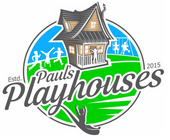
How to Build a Platform On a Hill
When it comes to backyard construction, it would be ideal if the grade was all perfectly flat and level, making foundational dilemmas a non-issue. Unfortunately, that is quite often not the case. After you've already made all of the other project considerations, what exactly are the options for building a shed or playhouse platform when your property has a hill or the ground has a steady slope, and how does one go about correcting for these uneven surfaces?
8 Foundation Options for Backyard Projects
For small residential outdoor projects, there are generally eight approaches you can employ for setting up your shed, playhouse or play-set support system. Some of these methods partly cross over each other in application, and range in cost, build time, stability, longevity and practicality.
Typically the steeper the drop-off, the greater realization these aspects will have. Play accessories such as ladders, climbing walls, slides and swing-sets will need to be adjusted from the plan specifications if significant grade changes occur. For the sub-infrastructures that are not attached to the ground, shed anchors can be used in high wind areas.
❶ Direct Grade Contact (DGC)
Pros
- Easy
- Cheap
Cons
- Impractical on hills
- Low stability & longevity
- Prone to settlement
By far the easiest, cheapest and most common option. For yards where the grade is mostly flat, frost upheaval isn't a concern and longevity is secondary, simply building the structure right on top of the ground is viable. Very moderate regrading may still be needed to keep the play structure level and plumb. The main drawbacks to DGC are it's impracticality with slopped yards, lesser longevity, additional required anchorage for high wind locations and susceptibility to settlement.

❷ Sand & Gravel
Pros
- Mild labor and cost intensive
- Mud control
- Safer play environment
Cons
- Impractical on hills
- Prone to settlement
For flat or shallow slopped yards, play sand and gravel beds provide another good option. The granular nature of these materials provide the benefit of exceptional hydraulic conductivity, easier leveling, softer surfaces for play and superior mud control. The drawbacks to sand and gravel are nearly the same as DGC.

❸ Concrete Slab
Pros
- High stability & longevity
- Mud control
Cons
- Impractical on hills
- Labor and cost intensive
- Poor safe play environment
This option is usually only applied if there's an existing patio. Concrete slabs provide the maximum amount of stability and longevity and do an excellent job of controlling mud. However, as with the above methods, this alternative is best suited for flat or low grade yards. Typically concrete should be avoided in high traffic play areas like a swing-set.

❹ Wood Skids
Pros
- Applicable for shallow slopes
- Mild labor and cost intensive
- Acceptable stability & longevity
Cons
- Impractical on moderate or steep hills
Similar to the cinder block skids and pier & beam support systems below, the wood skid foundation has the structure's joists rest on long stretches of 4x4s, 4x6s, 6x6s or 8x8s, which themselves are directly resting on the terrain. While this does further longevity by keeping the joists directly off of the ground, and potentially affords less regrading compared to DGC, it is still broadly limited in how steep the grade can be.

❺ Cinder Block to Joists
Pros
- Applicable for shallow to moderate slopes
- Mild labor and cost intensive
- Acceptable stability & longevity
Cons
- Impractical on steep hills
For small hills and low to moderately slopped grades, leveling the joists directly with cinder blocks is recommended. Using concrete or cinder blocks to make up the foundation has the benefit of minimizing excavation time, DGC separation, high stability and greater leveling flexibility. Most backyard structures on moderate slopes use this methodology. Concrete deck blocks, which have slots for 2x joists and 4x4 centers are very popular for this exact type of application.

❻ Cinder Block to Skids
Pros
- Applicable for shallow to moderate slopes
- Acceptable stability & longevity
Cons
- Impractical on steep hills
- Moderately labor and cost intensive
The cinder block to skid approach is a combination of the previous two foundational methods, utilizing cinder blocks to prop up the skids instead of DGC. This provides the advantage of the cinder block's larger leveling capacity, while also maintaining the skid's extensive and versatile support area, making post-construction orientation easier.

❼ Extended-Anchored-Posts
Pros
- Applicable for steep slopes
- High stability & longevity
Cons
- Labor and cost intensive
If the playhouse or play-set uses 4x4s as it's main skeletal supports (like the Red Summit plan), longer 4x4s can be purchased and anchored into the ground instead. This is a solid approach for moderate or high sloped areas.
Exact post placement and architectural positioning is critical if you go this route. Before digging the footers, check for proper distancing between all posts and that they are square. Before poring the concrete, attach solid spacers to insure proper post alignment all through the concrete curing process.



❽ Pier & Beam
Pros
- Applicable for steep slopes
- High stability
Cons
- Heavy labor and cost intensive
For high or severe sloped grades, a pier and beam foundation is often the only viable choice. Often this design is combined with #9 concrete pier style, though running the posts into the ground is common as well. P&B utilizes anchored posts/piers and skids/beams to support the structure’s starting joists. Unlike the previous method, ultra exact post placement isn’t required.
Because installing posts is much more cost and labor intensive than placing cinder blocks, beams are used instead of skids to reduce the number of piers. For larger projects, a water or laser level is favorable for achieving accurate and timely layouts. For more information on this method, check out our 12x12 island deck page.


❾ Concrete Piers
Pros
- Applicable for steep slopes
- High stability & longevity
Cons
- Heavy labor and cost intensive
Submerging the piers into the ground is common for light duty, residential construction projects, but for larger projects, using reinforced concrete piers is the standard. After the layout is marked and the holes dug, tube forms are used to make concrete anchors in the ground for the piers. This method yields the highest amount of strength and longevity to your project.




